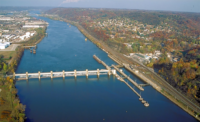A Senate committee has approved an $11-billion water-resources bill authorizing funds for 27 new Army Corps of Engineers projects. But in a striking change from similar past measures, the new one has an array of drinking-water and wastewater provisions, too, including a new trust fund. It also has funds to deal with water-system emergencies, such as the one that has hit Flint, Mich.
The Water Resources Development Act (WRDA), which the Environment and Public Works Committee cleared on April 28, authorizes about $5 billion in federal funds for new Corps navigation, flood-control, dredging, environmental restoration and other projects. The total includes $1.65 billion the committee added for two flood-control projects in the Sacramento area.
The committee’s 19-1 vote came just two days after its chairman, James Inhofe (R-Okla.), and top Democrat Barbara Boxer (Calif.) introduced the legislation.
Boxer told ENR that she is optimistic about the bill’s prospects. “When you have something come out 19-1 at this contentious time, I think we have some opportunities,” she says. “When it comes to infrastructure, there’s a lot more agreement than disagreement within the parties.” A committee aide said the panel is hopeful that floor action will take place in May or June.
The new bill has a much wider scope than its predecessors. Mike Strachn, a senior adviser with Dawson & Associates, Washington, D.C., says, “It is a water-resources development act in the broadest possible sense.” He adds, “It embraces water issues beyond the normal, traditional Corps of Engineers’ WRDA-type issues.”
Still, Strachn says that, as in past WRDAs, the “cornerstone” of the new Senate bill is its roster of projects that have favorable Army Chief of Engineers’ reports. By far, its largest allocation is a $976.4-million federal share for a $1.95-billion environmental restoration project in Florida’s Everglades.
About a half dozen of the projects are for port dredging, including $224.3 million for Charleston Harbor in South Carolina. The bill has other provisions that port officials had sought, says Jim Walker, American Association of Port Authorities director of navigation policy and legislation. They include a new alternate yardstick for determining the annual target for spending harbor-maintenance tax revenue and language to provide 75% federal funding for deepening harbors to 50 ft. Currently, the federal share for dredging to 45 ft is 75%; from 45 to 50 ft, the federal share is 50%.
The drinking-water/wastewater section includes $220 million for Flint and other areas affected by drinking-water emergencies. That amount includes $100 million for drinking-water state revolving funds, plus $70 million in subsidies for at least $700 million in Water Infrastructure Finance and Innovation Act loans. The bill has $1.4 billion over five years to help “small and disadvantaged communities” comply with the Safe Drinking Water Act and $300 million to replace lead service lines and address other, related uses.
National Association of Clean Water Agencies CEO Adam Krantz called the new WRDA “ambitious and innovative.” NACWA welcomes the $1.8-billion authorization for sewer-overflow control grants and language creating a trust fund for clean water and drinking-water infrastructure. Fees for a “voluntary labeling system” would feed the fund. The bill also reauthorizes a desalination statute and would establish “drought-resilience guidelines.”
A House WRDA proposal has yet to emerge.





Post a comment to this article
Report Abusive Comment